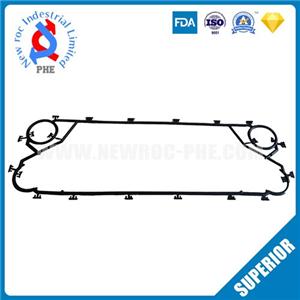The selection and design of plate heat exchangers need to know 5 parameters
The selection and design of plate heat exchangers need to know 5 parameters
Generally speaking, the selection and design of plate heat exchangers need to know 5 parameters:
The thermal power of the plate heat exchanger.
The temperature of the inlet water on the primary side of the plate heat exchanger.
The temperature of the outlet water on the primary side of the plate heat exchanger.
The inlet water temperature on the secondary side of the plate heat exchanger.
The outlet water temperature on the secondary side of the plate heat exchanger.
You can select the model if you know these 5 parameters. In addition, it is necessary to know the flow rate of the primary side when selecting and designing the plate heat exchanger, which is actually the result of dividing the power of the plate heat exchanger (converted into kcal) by the temperature difference between the inlet and outlet water on the primary side. The following explains the specific meaning of these 5 parameters.
1. The selection of flow velocity between heat exchanger plates is generally 0.2m/s as the lower limit, but the upper limit of 0.8m/s seems to be slightly lower. But it depends on the manufacturer's sheet corrugation.
2. The process of plate heat exchanger is determined. The process of plate heat exchanger is generally arranged as a single process in industry, so that it does not need to be dismantled to take over during maintenance. In medical-grade and food-grade plate heat exchangers, multi-process plate heat exchangers are widely used. Because these plate heat exchangers are generally relatively small.
3. The selection of the heat exchange area of the heat exchanger plate. The general choice of plate heat exchanger is to determine the diameter of the corner hole according to the flow rate. The flow rate at the hole is generally controlled to not exceed 6m/s, and the steam flow rate does not exceed 80m/s. After the hole size of the heat exchanger plate is determined, the series of the heat exchanger plate can be determined.
4. Selection of the flow direction of the plate heat exchanger. Generally, the plate heat exchanger is arranged in pure countercurrent flow.
5. Due to the large heat exchange area of the heat exchanger plates, the editor’s experience is that when the process requirements are met, the price should be considered. From the cost ratio of the area of the heat exchanger, the larger the cheaper, but the price of the whole machine must consider the price of the frame, so it should be considered comprehensively. The area of each heat exchanger plate is small, the frame price is low, but the unit price of the heat exchanger plate is high. Moreover, the area of a single chip is too small, and in addition to occupying a large area, it is generally difficult to achieve a single-process heat exchanger plate layout.




